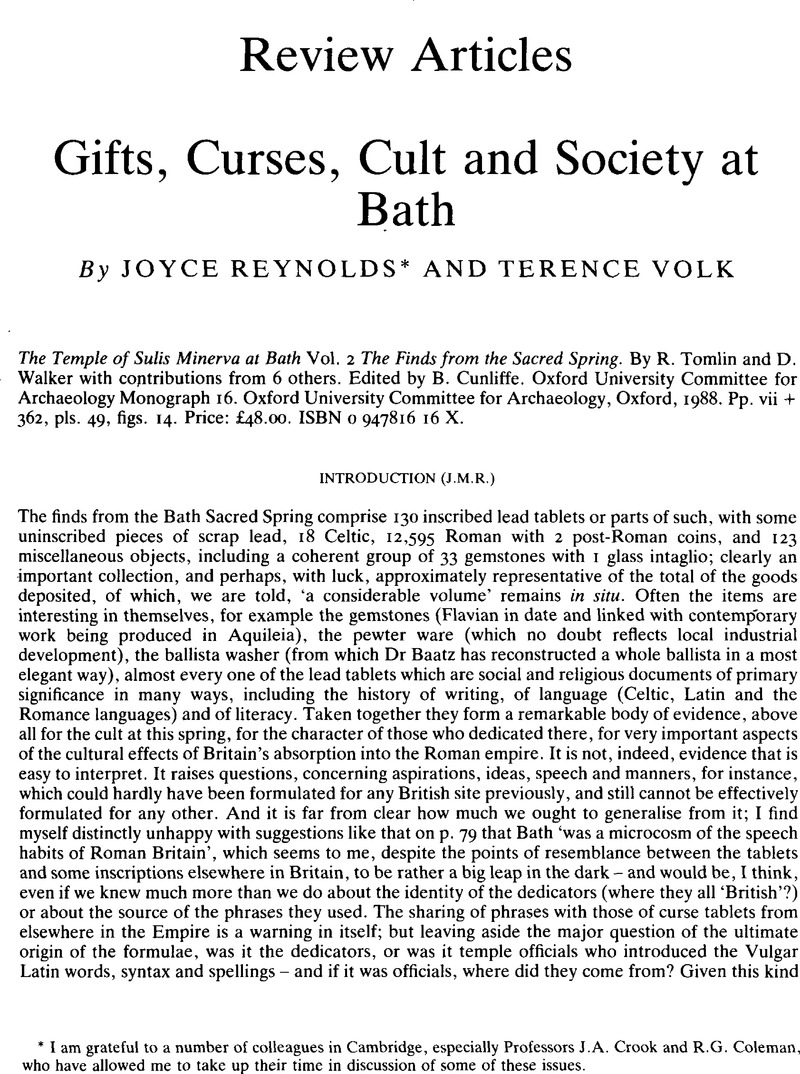Published online by Cambridge University Press: 09 November 2011

1 cf. Reece, R., ‘Numerical aspects of Roman coins hoards in Britain’, in Casey, J. and Reece, R. (eds.), Coins and the Archaeologist (1988), 86–101, at 95–6.Google Scholar
2 For differential ‘wastage', see Volk, T.R., ‘Mint output and coin hoards’, in Depeyrot, G., Hackens, T. and Moucharte, G. (eds.), Rhythmes de la production monetaire, de l'Antiquité à nos jours Actes du Colloque International organisé à Paris du 10 au 12 janvier 1986, Numismatica Lovaniensia 7 (1987) 141–221, at 147–55.Google Scholar
3 A selection of the evidence is given in Volk, T.R., La Donazione Chiellini, 1883–1983: i rinvenimenti monetali da Santo Stefano ai Lupi, (Museo Civico ‘Fattori, G.’) (1983), 100–1.Google Scholar
4 cf. Crawford, M.H., ‘Plated coins – fake coins’, NC7 8 (1968), 55–9, at 55.Google Scholar
5 The sample was drawn from the ‘Pompeii’ reports in Notizie degli Scavi, 1911, 1912, and 1913; ‘hoards’, purses, and other accumulations were ignored, ft cannot be excluded that the difference in the occurences of quadrantes among the finds from Pompeii and from Minturnae is due to archaeological method, though the systematic excavation at the latter site might be thought to have favoured a fuller recovery of the material. In any case, the picture at Minturnae is generally confirmed by the Luni excavations and, to a more limited extent, by those at Ordona.
6 The term ‘closed’ is to be understood here in a purely descriptive sense and not prescriptively, as in the case of the imperial province of Egypt.
7 Kraay, C.M., ‘The behaviour of early imperial countermarks’, in Carson, R.A.G. and Sutherland, C.H.V. (eds.), Essays in Roman Imperial Coinage presented to Harold Mattingly (1956), 113–36, at 119.Google Scholar
8 Giard, J.-B., ‘Le pèlerinage gallo-romain de Condé-sur-Aisne et ses monnaies’, RN 116 (1969), 62–97.Google Scholar
9 W. follows Hill, ‘The dating and arrangement of Hadrian's ‘COS III’ coins of the mint of Rome’, in dating this and the following issue; more generally, the ‘Britannia’ asses belong to the series of A.D. 119–120/1 (cf. Etienne/Rachet, note 11 below, 184–203) and the ‘Salus’ asses to the series of A.D. 128–9 (ibid, 245–52).
10 Carradice, I. and Cowell, M., ‘The minting of Roman imperial bronze coins for circulation in the East: Vespasian to Trajan’, NC 147 (1987), 26–50Google Scholar , at 28 and 38–43; and J. van Heesch in RBN 1989 (not seen).
11 BMCRE iii 1095, pl. xlv.4; BMCRE iii 1098 (‘legend obliterated’); Fitzwilliam Museum 1913–44; Étienne and Rächet, Le trésor de Garonne, pl. xxvii, 1902–4; FMRL iii, pl. xi, 44 (from Tetelbierg); Metcalf, , ANSMN 22 (1977), pl. viii, 5Google Scholar; and Walker, Temple of Sulis Minerva, pl. xxx, 13 (for references, see Walker, p. 336, nn. 22–5, and p. 338).
12 Etienne/Rachet, op. cit. (note 11), pl. xxvii, 1904. Note, however, that the most worn specimen (1903) also shows the countermark in its poorest state.
13 For the diffusion of the countermarked pieces, see Howgego, C.J., Greek imperial countermarks (1985), 294, no. 294.Google Scholar
14 Hill, op. cit. (note 9), places this issue in AD 122 on the grounds that the type refers to vows undertaken for Hadrian's safe return to the city of Rome; it belongs within the series of A.D. 120/1–3 (cf. Étienne/Rachet, op. cit. (note 11), 224–9).
15 Compare a ‘regular’ dupondius of this issue in Glasgow (HCC ii, pl. xxxi, 382) and a copper as from Bath (pl. xxxi, 45), both of a module close to that of W's ‘medallic’ specimen.
16 For a ‘corrected’ coin, see an overstruck orichalcum dupondius of P. Carisius (RIC 12 lib) in the Fitzwilliam Museum (Bunn 235–1950), the under-type of which is of the copper as of the same issue.
17 For this possibility, see now also Boon, G.C., ‘Counterfeit coins in Roman Britain’ in Casey, J. and Reece, R. (eds.), Coins and the Archaeologist2 (1988), 102–88, at 164, n. 140.Google Scholar
18 Crawford, M.H., ‘Finance, coinage and money from the Severans to Constantine’, ANWR 2, 2, 560–93, at 563.Google Scholar
19 The following summarises an argument developed in T.R. Volk, Revenue and coinage: problems of the Augustan principáte (RNS paper 1979).
20 cf. C.M. Wells, The German Policy of Augustus: an Examination of the Archaeological Evidence (1972), Table I at p. 268.
21 Carradice/Cowell, op. cit. (note 10), 29 and 43–6 (‘Commagene A’).
22 D.B. Waage, Antioch-on-the-Orontes, 4.2. Greek, Roman, Byzantine and Crusader Coins (1972), no. 1008; 2 pieces in the name of Tiberius.
23 Tiberius: BMCRE (3), Fitzwilliam Museum (6), HCC (0); Flavian: BMCRE (12), Fitzwilliam Museum (10), HCC (6).
24 The attribution of a second issue (BMCRE ii 893, p. 221, † & ‡, and p. 432), dated to A.D. 77/8, to Commagene is unproven; cf. Carradice/Cowell, op. cit. (note 10), 29 and 43–6 (‘Commagene B’).
25 Dated by BMCRE ii to AD 73, the year in which Domitian became COS II. It is, however, unlikely that the coinage began with an issue in the name of the junior prince, and a date during the following year before Domitian's designation as COS III is probable (see, in general, Buttrey, T.V., Documentary Evidence for the Chronology of the Flavian Titulature, Beiträge zur Klassischen Philologie 112 (1980), 33.Google Scholar
26 I owe this point to Miss J.M. Reynolds; cf. H. Mattingly's suggestion in BMCRE i, cxli, that the Tiberian coins were struck in honour of the province's annexation. But the picture from Commagene remains that of two one-off issues which, whether produced locally or at Rome, were distinguished by type-content (especially the absence of the S C formula) from the general Roman currency, unlike the groups designated as ‘special [British] inputs’ by W.
27 For a recent survey of the various formulae, see Cowell, M.R., ‘The application of chemical spectroscopie and statistical methods of analysis’ in Price, M.et al. (eds.), A Survey of Numismatic Research 1978–1984 2. Oriental Numismatics, Medals and Scientific Techniques (1986), 1022–40, at 1030–2.Google Scholar
28 The emended totals are: before c. A.D. 260: 7, 586; 260–96: 1945; 364–388: 264.